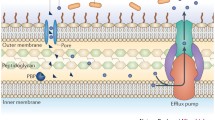Abstract.
The treatment of infectious disease is compromised by the development of antibiotic-resistant strains of microbial pathogens. A variety of biochemical processes are involved that may keep antibiotics out of the cell, alter the target of the drug, or disable the antibiotic. Studies have shown that resistance determinants arise by either of two genetic mechanisms: mutation and acquisition. Antibiotic resistance genes can be disseminated among bacterial populations by several processes, but principally by conjugation. Thus the overall problem of antibiotic resistance is one of genetic ecology and a better understanding of the contributing parameters is necessary to devise rational approaches to reduce the development and spread of antibiotic resistance and so avoid a critical situation in therapy—a return to a pre-antibiotic era.
Similar content being viewed by others
Author information
Authors and Affiliations
Rights and permissions
About this article
Cite this article
Mazel, D., Davies, J. Antibiotic resistance in microbes. CMLS, Cell. Mol. Life Sci. 56, 742–754 (1999). https://doi.org/10.1007/s000180050021
Issue Date:
DOI: https://doi.org/10.1007/s000180050021




